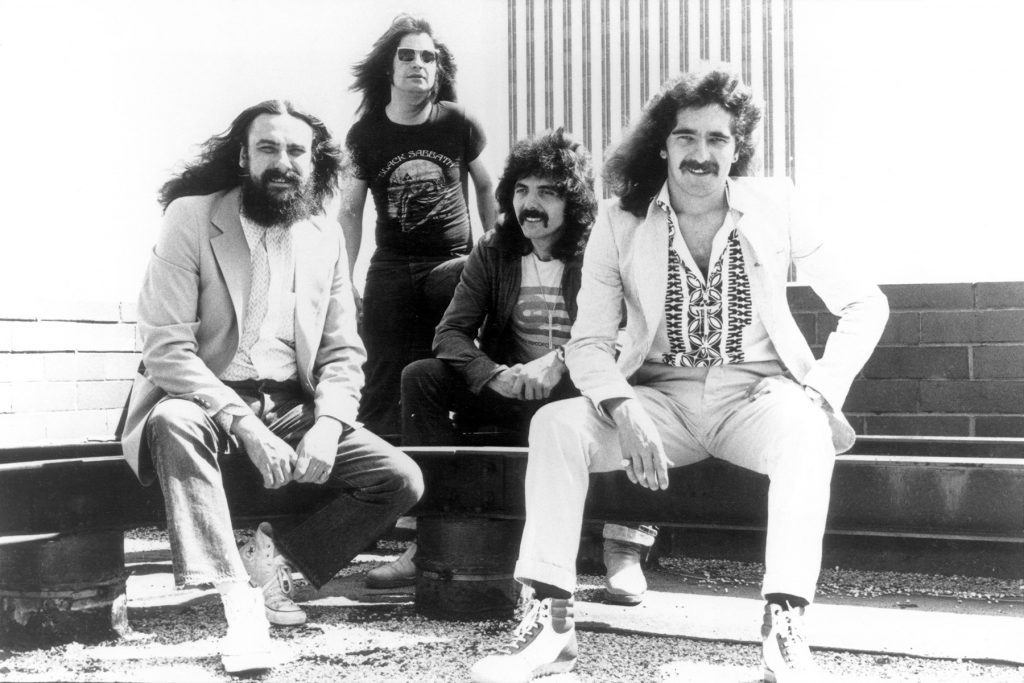
Liars’ Angus Andrew Breaks Down Each Spacey, Trippy Track on ‘The Apple Drop’
If a band’s discography is like a universe, Liars’ Angus Andrew is traveling through a wormhole on The Apple Drop, out Friday.
“[Working on this record] let me re-imagine the whole trajectory of what Liars has been,” he tells IndieLand. “I’ve really made a point with each record to experiment and try something brand new, a completely different way of working. I always imagine that as the kind of straight line of creativity, sort of pointing out into the distance. Working on this record, I started to realize that maybe that trajectory is more a bit like a spiral, and it’s sort of coming back into itself. Like, the stuff that you learn each time, you don’t totally disregard, so it does keep affecting the way things are working.”
As such, The Apple Drop mixes Liars elements old and new, bringing in characters from the shapeshifting avant-rock outfit’s past albums, as well as new collaborators, including Andrew’s wife, poet Mary Andrew, who contributed to the lyrics this time around. Andrew also teamed up with avant-garde jazz drummer Laurence Pike and multi-instrumentalist Cameron Deyell for an experimental studio session that yielded a hard drive full of music that became the basis for the record. Andrew spent much of the pandemic last year on the remote Australian island he calls home working on the album, which he says boasts some sci-fi themes.
blogherads.adq.push(function () {
blogherads
.defineSlot( ‘medrec’, ‘gpt-dsk-tab-article-inbody1-uid0’ )
.setTargeting( ‘pos’, [“mid-article”,”mid”,”in-article1″,”mid-article1″] )
.setSubAdUnitPath(“music//article//inbody1”)
.addSize([[300,250],[620,350],[2,2],[3,3],[2,4],[4,2]])
;
});
“I never thought I would make a sci-fi record; I don’t think this is, but I certainly was influenced by ideas of space travel and wormholes and dimensions and that sort of stuff,” he says. “I wanted to imagine the work as — not like a movie, but I wanted to write in a way that was like a screenplay. Just so that I could imagine how I was going to move the listener through the record.”
Andrew broke down each song on The Apple Drop in a conversation with IndieLand.
“The Start”
Well, that was the first song I finished for the record and it really set the tone for what I could imagine happening with the rest of the record. I saw it as the jumping-off point, blasting off in this spaceship kind of thing, setting out into space. Or really the way I was thinking about it was setting out into a journey of the mind, really, but the idea was to connect it with this idea of escaping gravity and heading out into the unknown.
In writing the record, I had spent time going back and connecting with past albums, and this character that I wanted to bring forward was from the very last song on the first Liars album [2001’s They Threw Us All in a Trench and Stuck a Monument on Top], which is called “This Dust Makes That Mud.” That character in that song is like a crazed insomniac, really, is sort of the easiest way to put it. I was trying to imagine that’s the person who is blasting off in this spaceship. They’re just overwhelmed, but with this journey ahead, they’ve started to gain some perspective.
“Slow and Turn Inward”
Following on, it’s like this person has just reached what I had imagined as the International Space Station, so sort of like the holding point for the next part of the journey. There’s a line in it, which is, “16 turns await us,” which is a reference to the ISS; it goes around the earth 16 times a day on average, which I like. I’ve just been really into trying to watch the ISS go overhead, as you can sometimes from Earth. I’ve got the app on my phone, and whenever I know it’s heading over, I always try and round up all the kids in my area. And we go out to a spot, and we watch it fly overhead. The kids get a real sense of wonder about it.
blogherads.adq.push(function () {
blogherads
.defineSlot( ‘medrec’, ‘gpt-dsk-tab-article-inbody2-uid1’ )
.setTargeting( ‘pos’, [“mid-article2″,”mid”,”in-article2″,”mid-article”] )
.setSubAdUnitPath(“music//article//inbody2”)
.addSize([[300,250],[300,251],[620,350],[2,4],[4,2],[3,3]])
.setLazyLoadMultiplier(2)
;
});
“Sekwar”
“Sekwar” is when things start to get interesting. There’s some sort of uprising or revolution that’s happening. Maybe it’s in the Space Station. Society has started to break down, and there is violence. And I feel like the character is at this point blurring into other representations of society. I do remember that I was writing this around the time of the storming of the Capitol and all that sort of stuff. So there was this … it was thick in the air, anger and protest and violence, and these kinds of things. That’s kind of the instigator of this, and it’s where I feel like the story starts to get interesting in the album, where it’s the first time you come across some problems.
“Big Appetite”
It seemed like on this journey we needed somewhere to escape from. I felt like I needed to pinpoint what that thing was that was problematic, so “Big Appetite” references the greed of the world and selfishness and those sorts of things. So this is where we understand what we’re escaping from. There’s a lot of big backing vocals in that track, which I always saw as a sort of a Greek chorus that are encouraging that violence and that greed. It really just became, to me, the most, well, unattractive, masculine, and muscly song on the record. It was all these kind of things that I think are problematic in the world, encompassed in that song.
“From What the Never Was”
This is the next single, actually. It’s a much more serene song about recollection, pondering the state of things and the past. I do remember I was listening to a lot of Ritual de lo Habitual, the Jane’s Addiction record, at the time, so I always think of [a Perry Farrell vocal line].
“Star Search”
This one is another example of where I wanted to take a character from the past record and bring them forward and see how they could evolve. I took the character from “The Other Side of Mt. Heart Attack,” which is the last song on [2006’s] Drum’s Not Dead, where it’s a character who’s isolated and talking about leaving and kind of vulnerable, saying, “I can always be found.” This character, when put into this song, is influenced by a female deity, almost represented by my wife who helped write a lot of these lyrics.
It’s an empowerment moment for this lost character, who’s sort of taken by the hand by this female and given strength from that. Sort of an all-knowing deity, I saw it as. I think there’s another example of the sort of Greek chorus toward the end of this one, where the backing vocals are starting to talk to the character about what they can and cannot do.
I’m kicking myself for never [having my wife write] before. Particularly because I just think the possibility of this female influence is so powerful and strong, and it’s like, “How could you leave that out before?” You know what I mean? I was really excited to be able to incorporate that viewpoint, which I think, obviously, it’s difficult to do if you’re not working with a female.
blogherads.adq.push(function () {
blogherads
.defineSlot( ‘medrec’, ‘gpt-dsk-tab-inbodyX-uid2’ )
.setTargeting( ‘pos’, [“mid”,”mid-articleX”,”in-articleX”,”mid-article”] )
.setSubAdUnitPath(“music//article//inbodyX”)
.addSize([[300,250],[300,251],[3,3],[620,350]])
.setLazyLoadMultiplier(2)
;
});
“My Pulse to Ponder”
It’s one of the oldest ideas I had going into the record, sort of a simple bass-line motif. But I just never really could figure out how to develop the song into something that worked for me. I saw it increasingly as this point where things had to get oversized and outlandish in the production and the ideas behind it. So it was really when I started to figure out the middle section of this song — which was introducing a horn section and, again, big backing vocals — that I was able to spin it into almost a carnivalesque freak show.
“Leisure War”
“Leisure” was a weird one. It’s like a very internalized thought process. I imagined it as sort of like reporting back — because we’re still on this theoretical journey — to wherever I come from with a very … well, not abstract, but a garbled impression of what I’ve experienced. I always imagine it sort of being beamed back in Morse code to wherever I’d come from. The first line is “death distance,” which I always imagined was me being as far away from the start as I get, where I’m almost out of communication and trying to stay connected in some small way.
“King of the Crooks”
I was joking with my wife that I should talk about this as an actual acknowledgment of when I was locked up in prison, but I never was. It’s more like this story within a story where I’m kind of imagining how the society, which is so based on surveillance and keeping people sort of in a box — this is me trying to usurp that kind of overarching power. The refrain is “pardoned felony.” I was imagining the panopticon, the Foucault idea of that society that is constantly keeping an eye on you, tracking you. I saw the prison in that way.
“Acid Crop”
So it felt like [this was] the titular track from the record … where you come to a point that you have to just resign to the laws of nature and gravity. So in the song, it sort of develops quietly with this kind of internal monologue until the song breaks open with a kind of heaviness. You need to just accept your fate.
[The title is a] play with the words. On my journey to naming the record The Apple Drop, I was playing with a lot of ideas having to do with LSD and psychedelics but also science and relativity — the laws of gravity and things like that. So I was initially thinking about the acid drop as that thing from the Sixties where everyone took LSD and changed the world, supposedly. But then, I wanted to obviously not be so literal, and so it became “Acid Crop,” which is kind of the idea of growing that psychedelia.
“New Planets New Undoings”
I always imagine this as kind of the ghost of the record. Looking back, it appears in this way where it floats in at the end. [It makes] talking about the past more of a recollection of how things occurred, and what I would have done differently had I been more aware. So it’s supposed to leave you with this chill.
blogherads.adq.push(function () {
blogherads
.defineSlot( ‘medrec’, ‘gpt-dsk-tab-inbodyX-uid3’ )
.setTargeting( ‘pos’, [“mid”,”mid-articleX”,”in-articleX”,”mid-article”] )
.setSubAdUnitPath(“music//article//inbodyX”)
.addSize([[300,250],[300,251],[3,3],[620,350]])
.setLazyLoadMultiplier(2)
;
});




